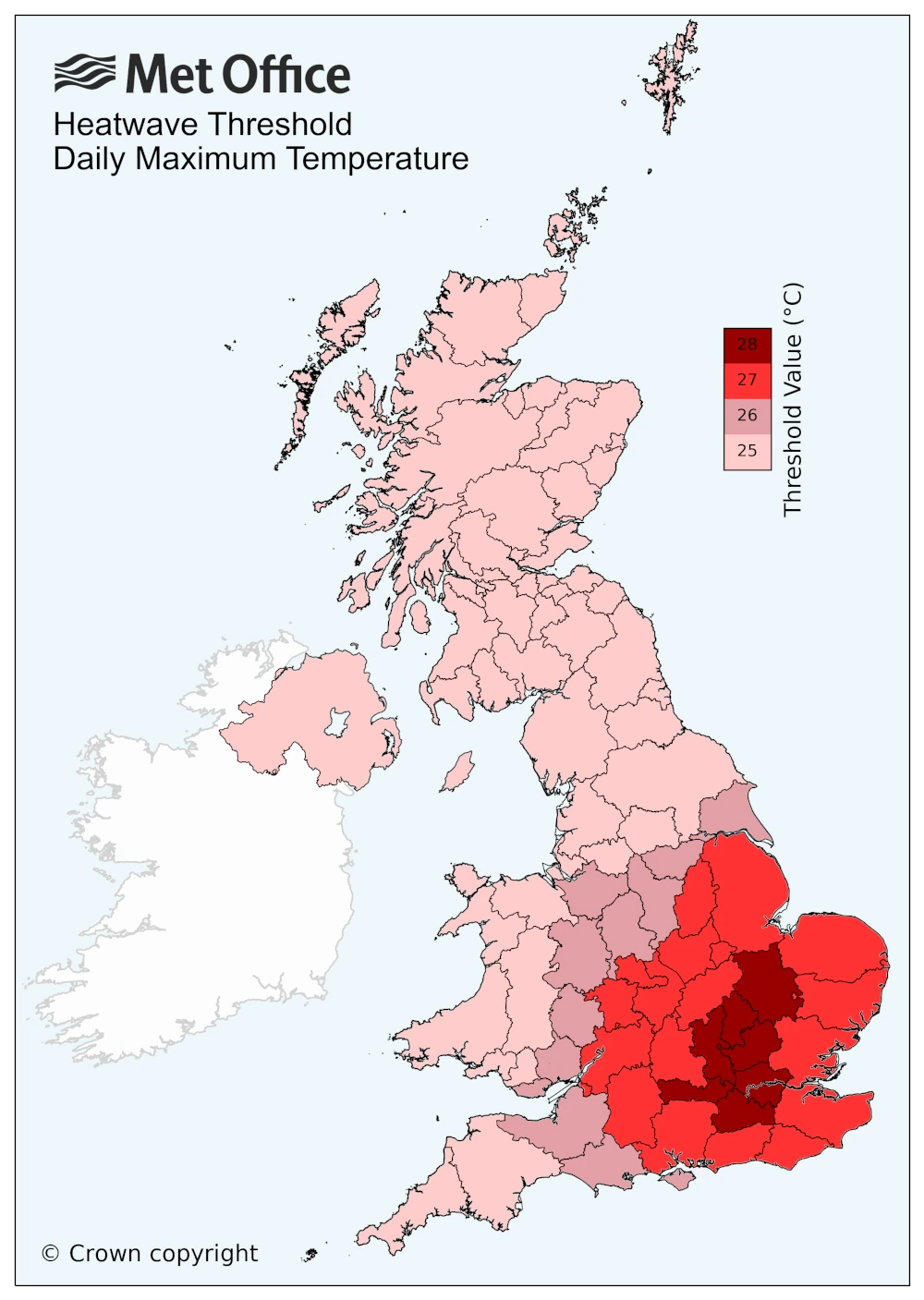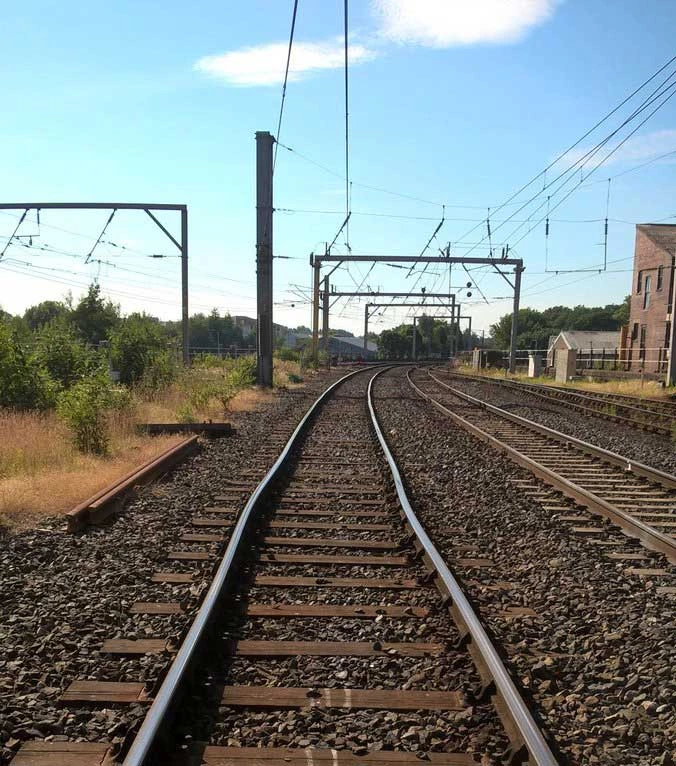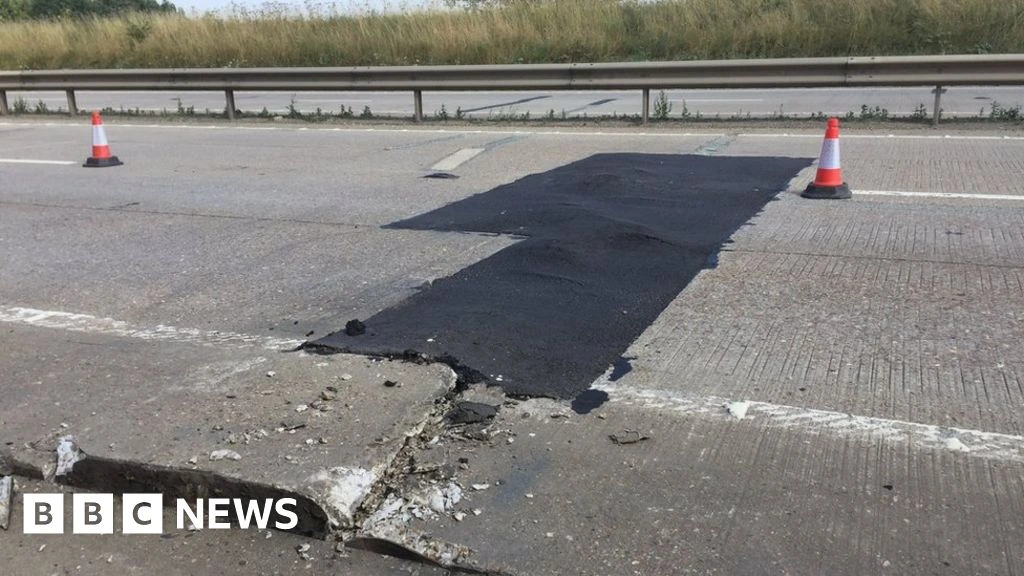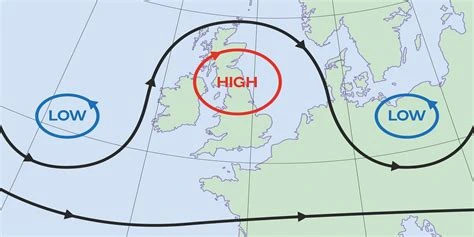Heatwaves and heat domes
Heatwaves have always been part of our climate from the Summer of 1976 to the extreme heat of July 2022 and seem to be becoming a more frequent feature of our Summers starting early than before and putting a strain on our infrastructure.

Heatwaves develop in the UK when High pressure forms either over the country or over the continent while Low pressure sits to our west. This is due to the jet stream moving north over summer and this allows high pressure to settle. The winds then draw up warm air from Europe or even as far S as Africa. In recent times it can also be a south westerly draw that produce temperatures high enough and long enough to be classed as a heat wave. This also means that high pressure these days isn't always needed to create a heat wave. To be classed as a heatwave temperatures have to be at a set level for three consecutive days. For Sheffield this will be 26C while further north 25C is the trigger. See the provided image for the requirements for your area. As the climate continues to warm these figures could actually be revised upwards. As average temperatures rise the level regarded as hot will also go up. So for example a very hot day in 1976 would just be classed as a hot day now. I would define a classic heatwave as one brought above by high pressure over the country and the modern heatwave one brought by south westerly air flow across the country as low pressure passes to the NW.
Heatwaves can be dangerous especially for the elderly and those summer from health issues. Modern houses are built to keep heat in so insulation traps the air in the house even more so upstairs as the heat has nowhere to go. Care homes aren't designed for excessive heat either. In recent times heatwaves have become much stronger with higher temperatures being recorded. At one time it would take several days for heat to build but these days temperatures can go from near average to hot to very hot within a day. Other effects of heatwave are rail lines buckling and as the climate warms we will need to replace rails with those that can handle higher temperatures. The rails in this country are stressed to a lower heat than those in Europe. Roads also melt in high temperatures although they are now in such a bad condition most motorists won't notice.


Heatwaves generally occur from May to August although some have happened in September. One of the effects of the present warming climate is that heatwaves can now occur well outside the Summer months and have started happening in Autumn. Heatwaves are also effected by Global circulation patterns so are more likely when El Niño occurs. El Niño generally warms the patterns and warms the climate. The opposite is true of La Niña which cools the planet. Most of the warmest years have occurred since 2000 and these years are heavily represented in the top twenty warmest months and years.
The most notable heatwave apart from 1976 was in July 2022 where 40.3C was reached the first time the 40C mark has been reached. The heatwave was short starting on the 16th and lasting to the 19th. The most interesting thing about this there wasn't any steady build up just cool to hot in one day with the reverse also being true. Sheffield broke records on the 18th with 35.5C 95.9F being the high and then again on the 19th when 38.3C 101.9F was reached. Before 1990 it was rare to record a 90F now it's quite common. Two days later the high temp was 18.8C. Possible by 2030's 100F maybe fairly common event in this country.
Another feature of heatwaves is a feature called a Heat dome. Heat domes are created when an area of high pressure stays located over the same area for days or even weeks. This happens when the jet stream weakens and then buckles. This can lead to a feature called an omega block or just general blocking where the high pressure stays in place for a long period.
The Omega block shown below was formed tends to stay stuck in the same position until the jet stream changes. In Winter the Omega block can provided prolonged cold while in summer it can lead to what is known as a heat dome. 1976 was a good example of a heat dome in practise. Once the block is formed heat becomes trapped under the high pressure and becomes hotter and hotter. The high pressure acts as a lid preventing the air from rising and actually causes it to sink. The air then warms by compression and the net heat is now smaller in volume which then allows the temperature to increase. and the heat builds.

The ground also warms , loses moisture and becomes easier to warm. Until the pressure pattern changes the heat will continue to build. The effects of this are drought due to increased evaporation and reduction in soil moisture. Heat Health issues and wildfires. Since the air is trapped it also creates smogs and increased pollution levels. Other effects side effects of heat domes are damage to trees mostly due to solar irradiation and foliage being scorched as a result of heat stress. Marine species are also effected by the stress of heat domes. Heat domes can also interact with low pressure systems which can lead to even more heat being drawn especially in the air is pulled up from a very warm source such as Africa for example. A heat dome was also responsible for the European heatwave of the 2025. The picture bottom left below shows a typical heat dome.

The heatwave of July 2022 was also related to a heat dome. More details on the record breaking heatwave can be found Click here. Some research indicates that heat domes could become more regular in future but only time will show whether this is true or not. If the climate gets warmer and more active it may reduce the chances of heat domes forming due to the weakening of the jet stream which then buckles making it easier for heat domes to form. This is due to the difference in temperatures between the poles getting less. The arctic for example is warming quicker then the rest of the planet. However other factors could also strengthen the jet streams. Time will tell which factor will win out.
Mitigating the effects of heat domes involves better urban planning which include more green trees, Cooler roofs and improving the ventilation. Houses in the UK are designed to keep heat in for example which is why upstairs is warmer as the hot air gets trapped by the insulation and cannot escape. The heatwave in 2025 made the inner walls of my house warm to touch where if the house had white insulation on the outside this wouldn't have happened. Better water management is also needed. A new Max temperature for working in needs to be agreed. We have one for when the workplace gets too cold one is needed for when it gets to hot. However UK Governments aren't very good at planning for such events in the future so there probably be an increase in heat related deaths amongst the vulnerable.